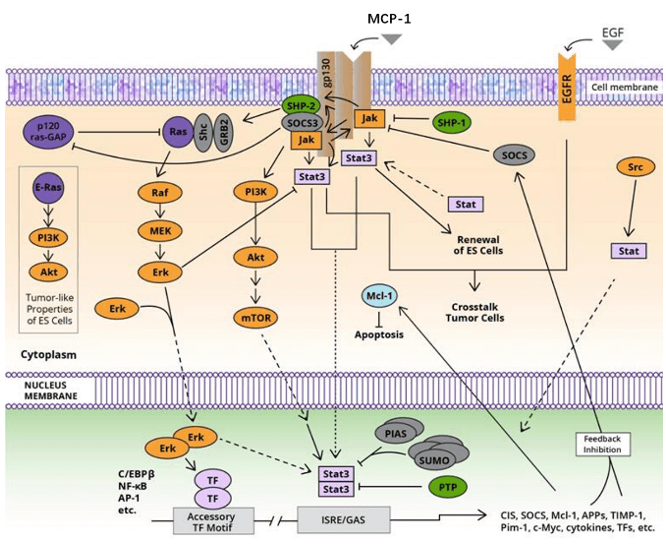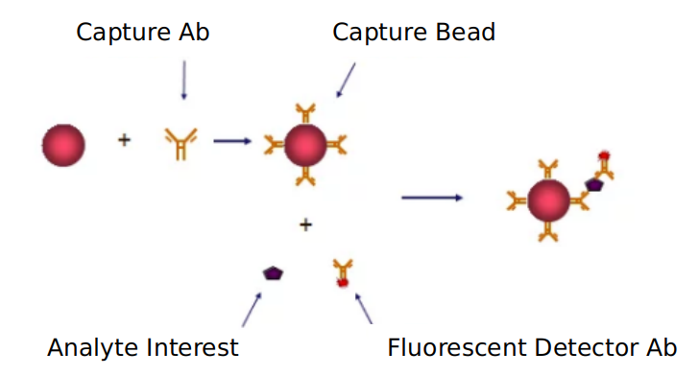MCP-1 signaling pathway
Based on Luminex technology platform, Creative Proteomics provides analysis services for key targets of MCP-1 signaling pathway.
 (Strieter RM, et al., 2019)Monocyte chemotactic protein 1(MCP-1), also known as monoctye chemotactic and activating factor (MCAF), is a member of the C-C subfamily (subfamily β). MCP-1/MCAF was initially identified from human myeloid monocyte line THP-1, glioma cell lines, and LPS or PHA-stimulated human PBMC culture supernatants. It is now known that monocytes, macrophages, fibroblasts, endothelial cells, B cells, and smooth muscle cells can be induced to secrete MCP-1 upon stimulation with PHA, LPS, Poly I-C, IL-1, IFN-γ, PDGF, EGF, or certain viruses.
(Strieter RM, et al., 2019)Monocyte chemotactic protein 1(MCP-1), also known as monoctye chemotactic and activating factor (MCAF), is a member of the C-C subfamily (subfamily β). MCP-1/MCAF was initially identified from human myeloid monocyte line THP-1, glioma cell lines, and LPS or PHA-stimulated human PBMC culture supernatants. It is now known that monocytes, macrophages, fibroblasts, endothelial cells, B cells, and smooth muscle cells can be induced to secrete MCP-1 upon stimulation with PHA, LPS, Poly I-C, IL-1, IFN-γ, PDGF, EGF, or certain viruses.
The human MCP-1/MCAF gene is localized to 17 pairs of chromosomes. The human MCP-1 precursor has 99 amino acids and is a basic protein. At the amino acid level, MCP-1 shares 62% and 72% homology with two other monocyte chemotactic proteins, MCP-2 (HC14) and MCP-3 (NC28), respectively, and 24% homology with IL-8 of the C-X-C subfamily.
The MCP-1 signaling pathway has chemotactic activity on monocytes, activates monocytes and macrophages, increases their intracytoplasmic Ca2+ concentration, superoxide anion production and release, and releases lysozyme, and upregulates monocyte and macrophage adhesion molecules can inhibit the growth of tumor cells. MCP-1 levels are significantly elevated in synovial fluid and serum of patients with rheumatoid arthritis, and synovial fluid tissue macrophages constitutively produce MCP-1, indicating that MCP-1 is associated with pathological damage in rheumatoid arthritis.
Our detectable targets:
| RTK | IRAK4 | JNK | mTOR | PKR | MEKK1 |
| PI3K | STAT5 | MYD88 | ISRE | TRAF5 | RIP1 |
| TYK2 | Vav | Rac1 | Fas | IRS1 | IRF9 |
| STAT1 | TBK1 | TLR4 | p38 | MEK6 | GAS |
| STAT2 | PI3K | CD3 | TLR9 | MHC-II | TRAF3 |
| STAT3 | MSK2 | IRF5 | Rel | p50 | RIG-1 |
| PSGL1 | ISGF3 | MEK3 | NAP1 | SLP76 | NFκB |
| IRS2 | TNFR | p38MAPK | MAPK | TRAM | Mda-5 |
| MSK1 | TRIF | SH2 | IRF3 | TCR | |
| TLR3 | Tak1 | TRAF6 | CREB | icam1 |
Technology platform:
We provide Luminex technology for MCP-1 signaling pathway analysis.
Luminex technology is a multifunctional liquid phase analysis platform, which is developed on the basis of high-speed digital signal processing technology, colored microspheres, applied fluidics and laser technology. The core is the use of fluorescent dyes for encoding. By adjusting the different ratios of different fluorescent dyes, more than 100 microspheres with different fluorescence spectra were obtained. The reactions are carried out on microspheres with different fluorescent codes, such as nucleic acid hybridization, antigen-antibody, enzyme-substrate, ligand-receptor binding reactions. Using laser detection technology, qualitative and quantitative analysis of microsphere encoding and reporting fluorescence.
Advantages of MCP-1 signaling pathway detection:
- High throughput: It can analyze more than 100 target molecules in the same sample at the same time.
- Low sample consumption: Due to the small size of the microspheres, samples as low as 1 puL can be detected, and 100 different target molecules can be detected simultaneously in the same reaction well, which greatly saves the amount of sample.
- The operation is simple and quick: The liquid phase system is adopted, the reaction time is fast, and the detection of various cytokines can be completed within 2-3 hours.

Application of our service:
- Study the impact of each clinical virus on the MCP-1 signaling pathway
- Research on the regulatory mechanism of MCP-1 signaling pathway in medicine
Creative Proteomics has developed a signaling pathway target detection platform. We can provide detection services not only for MCP-1 signaling pathways, but also for other signaling pathways. If you want to detect other targets, please contact us in advance and we will customize the service for you according to your requirements. Looking forward to working with you.
References:
- Strieter RM, Koch AE, et al. The immunopathology of chemotactic cytokines: the role of interleukin-8 and monocyte chemoattractant protein-1. Lab Clin Med, 2019, 4(123): 183-197.
- Jia T, Serbina NV, et al. Additive roles for MCP-1 and MCP-3 in CCR2-mediated Recruitment of inflammatory monocytes during Listeria monocytogenes infection. Immunol, 2018, 180: 6846-6853.



